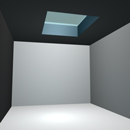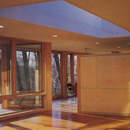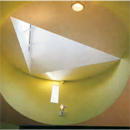
Light Trap
Light Trap refers to natural light that is captured through a deep hole in the ceiling or wall and is contained within the opening. more
Light Trap | House
application
In house design a Light Trap becomes a ceiling feature in a variety of rooms in public and private spaces alike.
research
Light Trap refers to a hole in a closed contour with enough depth, thickness or density, in order to capture and accumulate within it natural or artificial light. According to Fuller Moore in Concepts and Practice of Architectural Daylighting, “Closely spaced contours represent a strong illuminance gradient.”1 This illuminance gradient differentiates Light Trap from skylight, which is a “small opening in a roof, or in the ceiling of a room, filled in with glass, for admitting daylight”.2 Skylight differs from Light Trap, because it is always overhead and built to introduce illumination into a room without necessarily trapping it. For instance, a skylight can be just surface light as it occurs in warm climates were the thinness of the roof and the absence of insulation eliminates the deep hole for trapping light. Although in colder climates Light Trap more commonly exists in skylights, its formation is unconscious and not necessarily planned. Only by observing the capacity of a deep hole to trap light and detaching it from the connotations a skylight implies, Le Corbusier was able to manipulate color and light through the walls at the chapel of Notre Dame du Haut in Ronchamp. With the same understanding, Architröpolis Corporation trapped light into the wall of a 2006 residence at Austin. To emphasize the presence of the trapped light, both Le Corbusier and Architröpolis tinted the light--the first one by color painting the trap’s hole and the second one by incorporating a colored filtering glass within it.
The reason why Light Trap is more often found in ceiling surfaces is due to its functional benefits. “Overhead sources produce greater illuminance than side sources . . . while high window locations reduce glare from high-brightness exterior areas, they increase the potential of deep sunlight penetration . . . (zenith luminance is three times that at the horizon) and is less subject to obstruction from surrounding trees and buildings.”3 “Because illuminance is a function of both apparent size and cosine reduction, higher fenestration provides more uniform distribution than comparable lower locations.”4 At the entrance (capture of light), the light is concentrated in the hole (contention of light), but once it passes the hole reaching the space, the light is spread (dispersion of light). This concept responds to three types of light conforming a light cycle: light at motion, light at tension, and light at rest. The cycle consists in, the light first traveling freely through the air (light at motion), then falling into the hole and being trapped (light at tension), and last being dispersed (light at rest). Light Trap becomes visible when the light is at tension. As the cycle of light never stops during the daytime, Light Trap is always visible. Meanwhile, at night time it disappears and becomes a dark hole as if the surface containing it had closed itself to the outside. The obscure hole now becomes a void--cold instead of warm as when lit.
For its great brightness, Light Trap steals attention from the surface plane containing it, becoming the most eye-catching point or focal point of it. Other than providing accent light, Light Trap frees the imagination of the room’s inhabitant. This attribute depends on seasonal effects and is especially important in small spaces. “A young man recalled his hall bedroom at the top of a city boarding-house as the site for imaginary travel. Although his room was the size of a closet, it had a window which broke through the roof . . . Covered in snow, the . . . [Light Trap] gives a greenish light and he imagines he is in a cave rather than on a ship” as in summer times.”5
In antiquity, Light Trap was not possible, because the available technology did not allow for its construction and the interior space was not valued like the exterior. In Greece for example, the temples “were of post-and-beam stone construction with timber roofs. They were ‘object buildings’ designed to be viewed from the exterior rather than inhabited.”6 Subsequently, “[a] number of Roman architectural developments allowed the use of day-lighting and passive solar heating [to] increase substantially.”7 The development of new architectural forms, allowed the use of masonry materials, permitting larger spans and larger uncolumned interiors, which created a potential to admit light. Tracing western history, the Romans were the first to utilize Light Trap in the design of their buildings. The Pantheon in Rome, from A.D. 120-124, has a dome pierced by a deep oculus that traps light.
In 1813, John Soane experimented with his own house in London to create windowed domes that would provide spaces with detailed simplicity.8 For the breakfast room he created a flattened dome perforated in its center to trap light. Because the Trap Light effect was lost at night, he hung an artificial lighting fixture in the hole to compensate for the loss of natural illumination. Soane’s multiple innovations, of perforating the dome, were often drawn from ancient Rome.
In 1950 Frank Lloyd Wright used multiple Light Traps in the Walter House. He designed a concrete roof perforated in a grid manner that filled the interior spaces with natural light. Because the concrete slab was deep enough, the perforations generated Light Trap instead of surface light. Similarly in 1981, Marcel Breuer and Herbert Beckhard used sequential Light Traps that better distributed light into the space, and in 1995, Dean/Wolf Architects further emphasized the presence of the various Light Traps by giving them a distinctive color.
A single Light Trap is employed in various locations in houses, including those in the center of a living room. In 1977 Jay Crawford and Anthony Tortora marked the center of a breakfast room; in 1980 Myron Goldfinger's Light Trap becomes the feature in a bedroom, and in 2006 Architröpolis Corporation marked the center of a vestibule. In recent years, other than a lighting effect, Light Trap has acquired a sculptural form contributing to the volumetric composition of the house. Instead of a simple and cylindrical or rectangular perforation on a wall or ceiling plane, Light Trap challenges the tectonics of roof volumes with more elaborate cuts.9
end notes
- 1) Fuller Moore, Concepts and Practice of Architectural Daylighting (New York: Van Nostrand Reinhold, 1985), 22.
- 2) Oxford University Press, “Skylight,” Oxford English Dictionary, http://dictionary.oed.com/.
- 3) Moore, Concepts and Practice, 69.
- 4) Moore, Concepts and Practice, 69.
- 5) Elizabeth Collins Cromley, “Sleeping Around: A History of American Beds and Bedrooms: The Second Banham Memorial Lecture,” Journal of Design History 3, no.1 (1990): 13.
- 6) Moore, Concepts and Practice, 4.
- 7) Moore, Concepts and Practice, 6.
- 8) John Pile, A History of Interior Design (New York: John Wiley & Sons Inc., 2000), 174.
- 9) Evidence for the use and the chronological sequence of Light Trap as a house archetype was developed from the following sources: 1970 Private House [1976] Sunshine Design; Ludlow, VT; in "On a Vermont Mountain, an Integral System for Solar Collection, Storage and Transfer," Architectural Record 160, no. 7 (Nov. 1976): 112; PhotoCrd: Robert Perron; Jay Crawford and Anthony Tortora Beach House [1977] Jay Crawford and Anthony Tortora; Fire Island, NY in Anonymous, "Fire Island Weekend House," Interior Design 48, no, 8 (Aug. 1977): 119; PhotoCrd: Richard Champion / 1980 Aldo van den Nieuwelaar House and Studio [1987] Aldo van den Nievwelaar; Amsterdam in Edie Lee Cohen, "Fortuitous Finding," Interior Design 58, no. 6 (Apr. 1987): 307; PhotoCrd: Tjeerd Frederikse / 1990 Spiral House (Dr. Andrew and Lisa Goldberg House) [1995] Dean Wolf Architects; North Castle, NY in Charles K. Hoyt, "Hitting Bedrock," Architectural Record 183, no. 4 (Apr. 1995): 67; Zumikon House [1995] Gwathmey Siegel and Associates Architects; Lake Zurich, Zumikon, Switzerland in Tracy Metz, "Living with Art," Architectural Record 66, no. 4, Record Houses 1995 (Apr. 1995): 79; PhotoCrd: Richard Bryant/Arcaid; Tom and Susan Rosenthal House [1997] J. Frank Fitzgibbons; Santa Monica, CA in Edie Cohen, "Geometry Lesson," Interior Design 68, no. 4 (Mar. 1997): 134; PhotoCrd: Toshi Yoshimi / 2000 Dallas Austin House [2006] Architropolis Corporation; Michael Czysz, Architect, Atlanta, GA in Georgia Dzurica, "The Starship Serenity," Interior Design 77, 1 (Jan. 2006): 183, 185; PhotoCrd: Eric Laignel.
bibliographic citations
1) The Interior Archetypes Research and Teaching Project, Cornell University, www.intypes.cornell.edu (accessed month & date, year).
2) Mendez, Marta. “Theory Studies: Archetypical Practices of Contemporary House Design.” M.A. Thesis, Cornell University, 2008, 53-62.



